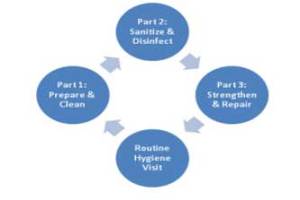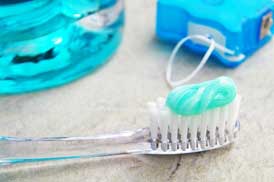Bad breath, always the first thing you think about when right before you open your mouth. ‘Does my breath smell bad? I can’t tell, it must smell bad…’ You breathe, you sniff, and still you just can’t tell. That moment of doubt can ruin a social situation by flooding you with insecurity. So what do you do?
‘Does my breath smell bad? I can’t tell, it must smell bad…’ You breathe, you sniff, and still you just can’t tell. That moment of doubt can ruin a social situation by flooding you with insecurity. So what do you do?
- Although caused by many things, the top reasons your breath may not be as fresh usually is from a few common problems. Such as: poor oral hygiene, diet and nutrition, or some health problems such as dry mouth, acid reflux or debris from post nasal drip and respiratory tract infections.
- To keep your bad breath under control try to avoid garlic and onions. These types of foods can stay in your system for up to 72 hours after your consumed them. Cigarettes, coffee and other odor inducing foods can hang out on the back of your tongue and between your teeth as well. Be sure to brush and floss after you eat and follow with a good mouth rinse. Maintaining a well balanced diet and keeping hydrated as well can help reducing bad breath as well.
- Be sure you actually have bad breath, check with a friend if you really aren’t sure, or if you are able to, run some floss through your teeth and smell. If your floss is discolored or has a bad odor there is a good chance your breath is smelling the same. Interestingly enough there is a small percentage of the population who believe they have bad breath when they do not and patients who are obsessed with their breath. These people are categorized as being either halitophobic’s or pseudo-halitosis patients.
- Keep in mind that although gum, breath mints and some mouth rinses are short term quick fixes if you have chronic bad breath or halitosis be sure to see your dentist and evaluate what can be causing it.


 Ever look on the back of the toothpaste box and wonder, what exactly is xanthan gum and why the heck is it in my toothpaste? Well wonder no more, as we go through how to decode the toothpaste label…
On every drug facts label you find a listing of active ingredients and inactive ingredients, as well as what its used for, any warnings for the product and directions for uses.
Active Ingredients: This is the part of the toothpaste that makes its use effective. In the case of most toothpastes the active ingredient is usually for anti-plaque, anti-cavity, anti-gingivitis as well as including ingredients to help prevent tooth sensitivity. So in this portion you will normally see your fluorides such as sodium fluoride, stannous fluoride or sodium monofluorophosphate. You may also see potassium nitrate, triclosan, pyrophosphates or zinc salts as well as a myriad of other ingredients.
Inactive Ingredients: This portion includes the ingredients that make the toothpaste standup to being on the shelf as well as completing the nuts and bolts function of general toothpaste use. So these ingredients stop the paste from drying out, keep it at a good pH, stop microbial growth, make them thick enough for use and help them become foamy when used. They also include flavoring agents, abrasives and whitening agents. So in this section, which in my opinion is the most confusing you’ll see these types of ingredients:
Ever look on the back of the toothpaste box and wonder, what exactly is xanthan gum and why the heck is it in my toothpaste? Well wonder no more, as we go through how to decode the toothpaste label…
On every drug facts label you find a listing of active ingredients and inactive ingredients, as well as what its used for, any warnings for the product and directions for uses.
Active Ingredients: This is the part of the toothpaste that makes its use effective. In the case of most toothpastes the active ingredient is usually for anti-plaque, anti-cavity, anti-gingivitis as well as including ingredients to help prevent tooth sensitivity. So in this portion you will normally see your fluorides such as sodium fluoride, stannous fluoride or sodium monofluorophosphate. You may also see potassium nitrate, triclosan, pyrophosphates or zinc salts as well as a myriad of other ingredients.
Inactive Ingredients: This portion includes the ingredients that make the toothpaste standup to being on the shelf as well as completing the nuts and bolts function of general toothpaste use. So these ingredients stop the paste from drying out, keep it at a good pH, stop microbial growth, make them thick enough for use and help them become foamy when used. They also include flavoring agents, abrasives and whitening agents. So in this section, which in my opinion is the most confusing you’ll see these types of ingredients:
 After years in the dental office, I can tell you that it’s very rare to find a patient who goes more than 3 years without a cavity.
Knowing that home care is one of the most important aspects of maintaining a healthy mouth, my partners and I set out on creating a home care regimen that’s relatively easy and will provide the results we are hoping to achieve, a decrease in cavities and improvement in overall oral health.
The final breakthrough of my home care routine recommendations came while reading Dr. Ellie Phillips book Kiss Your Dentist Goodbye. During our daily care routine, we are mainly focusing on removing and repairing the damage we’ve already done during the day. Removing plaque mostly and strengthening enamel. However, Dr. Ellie’s book brings up a great point, we aren’t focusing on improving the overall environment of the mouth, more specifically saliva makeup.
Combining both rationales, ours which focuses on mechanics and repair, and Dr. Ellie’s which focuses on reducing the saliva’s acidity and creating a healthier environment in the mouth, we created Frangella Dental’s basic home care regimen:
After years in the dental office, I can tell you that it’s very rare to find a patient who goes more than 3 years without a cavity.
Knowing that home care is one of the most important aspects of maintaining a healthy mouth, my partners and I set out on creating a home care regimen that’s relatively easy and will provide the results we are hoping to achieve, a decrease in cavities and improvement in overall oral health.
The final breakthrough of my home care routine recommendations came while reading Dr. Ellie Phillips book Kiss Your Dentist Goodbye. During our daily care routine, we are mainly focusing on removing and repairing the damage we’ve already done during the day. Removing plaque mostly and strengthening enamel. However, Dr. Ellie’s book brings up a great point, we aren’t focusing on improving the overall environment of the mouth, more specifically saliva makeup.
Combining both rationales, ours which focuses on mechanics and repair, and Dr. Ellie’s which focuses on reducing the saliva’s acidity and creating a healthier environment in the mouth, we created Frangella Dental’s basic home care regimen:
 Being a dentist and being surrounded by a lot of dentists, I’ve had the opportunity to try a lot of dental products over the years and learn the opinions of my friends, family and colleagues about these same products.
I decided to compile a list of my absolute favorite, tried and true, dental products on the market. Of course I’m always open to try something new, so if you have any favorites, please let us know!
Being a dentist and being surrounded by a lot of dentists, I’ve had the opportunity to try a lot of dental products over the years and learn the opinions of my friends, family and colleagues about these same products.
I decided to compile a list of my absolute favorite, tried and true, dental products on the market. Of course I’m always open to try something new, so if you have any favorites, please let us know!
